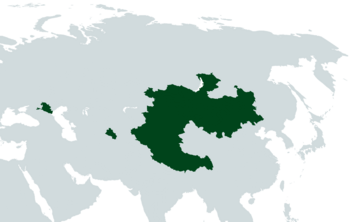Mongol Uls
Khanate of the Mongol Uls Mongol Ulusyn Khanlig | |
|---|---|
| Anthem: Chinggis Khaanii Magtaal | |
 | |
| Capital and largest city | Kharkorin |
| Official languages | Khalkha Uzbek |
| Recognised national languages | Tuvan Buryat Tibetan Uyghur |
| Ethnic groups |
|
| Demonym(s) | Mongol |
| Government | Asymmetrical federal parliamentary real union |
• Bogd Gegeen | Manduul Temujin |
• Prime Minister | Etsegh-ek Törin |
| Legislature | Kurultai |
| History | |
• Onon Kurultai | 1206 CE |
• Qing Conquest | 1758 CE |
• Soviet Occupation | 1921 |
• Coronation of Manduul Temujin | 2019 |
| Area | |
• Total | 6,400,000 km2 (2,500,000 sq mi) |
| Population | |
• 2023 estimate | 59,978,231 |
• 2020 census | 56,023,745 |
| GDP (nominal) | 2020 estimate |
• Total | $199 billion |
• Per capita | $3321.46 |
| Currency | Sum (mns) (MNS) |
| Date format | dd-mm-yy |
| Driving side | left |
| Internet TLD | .ml |
The Mongol Uls, officially the Khanate of the Mongol Uls (Khalkha Mongolian: Mongol Ulusyn Khanlig), is a nation located in Central Asia, bordering Russia, China, and the Turkic Union. Composed of its heartland, referred to as Mongolia, as well as the federacy of Gurkaniyan, the free city of Kharkhorin, and areas under the jurisdiction of the militant Second Golden Horde, the Khanate claims the legacy of the ancient Mongol Empire.
While a Mongol state in some form has existed since the Onon Kurultai in 1206 CE, the present-day Khanate was created in 2019, when Nyamaagiin Khaltar was recognised by the 14th Dalai Lama as the 10th Jebtsundamba Khutuktu, and hence the Bogd Gegeen, heir to the Bogd Khan. After a lengthy public debate, a referendum led to Khaltar being installed as Manduul Temujin, the 10th Bogd Gegeen and Khan of All Mongolia, the head of state of a new Mongol Khanate. In 2021, the Mongol Uls announced plans to form a real union with the newly-established Turkic state of Gurkaniyan, and with a previously-sovereign militia known as the Second Golden Horde. Together, the three entities formed what became known as the current Khanate of the Mongol Uls.
The Khanate of the Mongol Uls is the world's second-largest country by land area, although it is very sparsely populated. Its wide jurisdiction and strategic location have led to its controlling a powerful military position, and it is beginning to be considered to be a great power. Its assumption of the administration of Russia in 2022 and its significant sway over both the Turkic Union and the most prominent Chinese military faction have led to it increasingly becoming an international powerbroker.
Etymology
The term "Mongol Uls" can be roughly translated as "Mongol State". The Mongol Uls is often referred to by the metonym of "Mongolia"; however, this is neither the Khanate's official name nor an accurate description, as the Khanate controls territories in areas that are far from the Mongol steppe. Rather, "Mongolia" is a designation for a geographical region within the greater Khanate, which is used for demographic and electoral purposes.
History
Ancient History
Early Modern History
Modern History
Politics
Government
The Mongol Uls is a parliamentary constitutional monarchy, with a figurehead monarch as the Head of State and a supreme parliament, the Kurultai. The Kurultai is elected every two years, and serves to pass legislation and provide confidence and supply to the Cabinet. The Cabinet, and the executive branch as a whole, are both led by the Prime Minister (Khalkha Mongol: Yerönkhii Said), who is the Head of Government. The judiciary is independent of the other branches; a technocratic model of judicial appointments is used, with the Judicial Appointments Board recommending magisterial candidates at all levels of government.
Administrative Divisions
The Mongol Uls is divided into four main subdivisions: Mongolia, the Emirate of Gurkaniyan, the City of Kharkorin, and the Golden Horde Jurisdictional Zones. Mongolia is the largest subdivision, but has no autonomy; regional issues are dealt with at the aimag level. There are 6 aimags: Outer Mongolia, Inner Mongolia, Buryatia, Kalmykia, Tuva, and the Altai. The Emirate of Gurkaniyan is the most autonomous subdivision; it is considered to posses its own sovereignty and rights to self-determination, in a setup similar to that of the associated states of New Zealand.